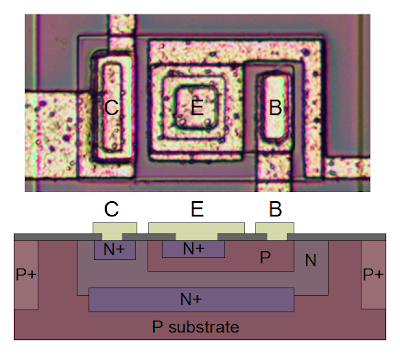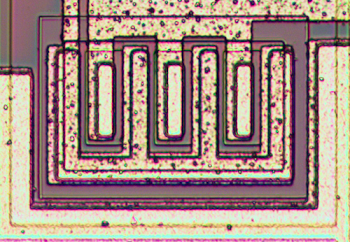
Why op amps are important
Op amps are a key component in analog circuits.
An op amp takes two input voltages, subtracts them, multiplies the difference by a huge value (100,000 or more), and outputs the result as a voltage.
If you’ve studied analog circuits, op amps will be familiar to you, but otherwise this may seem like a bizarre and pointless device. How often do you need to subtract two voltages? And why amplify by such a huge factor: will a 1 volt input result in lightning shooting from the op amp? The answer is feedback: by using a feedback signal, the output becomes a sensible value and the high amplification makes the circuit performance stable.
Op amps are used as amplifiers, filters, integrators, differentiators, and many other circuits.[2]
Op amps are all around you: your computer’s power supply uses op amps for regulation.
Your cell phone uses op amps for filtering and amplifying audio signals, camera signals, and the broadcast cell signal.
The structure of the integrated circuit
NPN transistors inside the IC
Transistors are the key components in a chip.
If you’ve studied electronics, you’ve probably seen a diagram of a NPN transistor like the one below, showing the collector (C), base (B), and emitter (E) of the transistor, The transistor is illustrated as a sandwich of P silicon in between two symmetric layers of N silicon; the N-P-N layers make a NPN transistor.
It turns out that transistors on a chip look nothing like this, and the base often isn’t even in the middle!
The photo below shows one of the transistors in the 741 as it appears on the chip.
The different brown and purple colors are regions of silicon that has been doped differently, forming N and P regions.
The whitish-yellow areas are the metal layer of the chip on top of the silicon – these form the wires connecting to the collector, emitter, and base.
Underneath the photo is a cross-section drawing showing approximately how the transistor is constructed. There’s a lot more than just the N-P-N sandwich you see in books, but if you look carefully at the vertical cross section below the ‘E’, you can find the N-P-N that forms the transistor. The emitter (E) wire is connected to N+ silicon. Below that is a P layer connected to the base contact (B). And below that is a N+ layer connected (indirectly) to the collector (C).[3]
The transistor is surrounded by a P+ ring that isolates it from neighboring components.
PNP transistors inside the IC
You might expect PNP transistors to be similar to NPN transistors, just swapping the roles of N and P silicon. But for a variety of reasons, PNP transistors have an entirely different construction.
They consist of a circular emitter (P), surrounded by a ring shaped base (N), which is surrounded by the collector (P).[4] This forms a P-N-P sandwich horizontally (laterally), unlike the vertical structure of the NPN transistors.
The diagram below shows one of the PNP transistors in the 741, along with a cross-section showing the silicon structure.
Note that although the metal contact for the base is on the edge of the transistor, it is electrically connected through the N and N+ regions to its active ring in between the collector and emitter.
The output transistors in the 741 are larger than the other transistors and have a different structure in order to produce the high-current output. The output transistors must support 25mA, compared to microamps for the internal transistors. The photo below shows one of the output transistors. Note the multiple interlocking “fingers” of the emitter and base, surrounded by the large collector.















